50th ANNIVERSARY EDITIONS
miyazaki chair
MIYAZAKI CHAIR FACTORY
INTRODUCTION
Discovering the Miyazaki collection felt like love at first sight. Introducing the brand on the European market an honor.
Very quickly it became clear that the Miyazaki Chair Factory was not a manufacturer like any other. Designers can come to them with designs no other manufacturers can make because of their difficulty or the fact that production is too time-consuming and not economically viable enough. Patience, excellent craftsmanship and love for the trade distinguish the Miyazaki Chair Factory from many others.
It is not about being able to produce fast or in large quantities. Achieving the best possible result remains the only motivation, the rest will follow. The Miyazaki collection is so much more than a collection of pieces of furniture, it is the result of the work and dedication of many. Everyone is closely involved by Masahiro Miyazaki in every step of the production process and this in all its aspects which creates a great involvement of everyone within the Miyazaki group.
Therefore this booklet is an ode to the Miyazaki Chair Factory.
With my best and warmest regards,
Kathy Alliët
ceo pas-partoe agenturen, N.V./S.A. Distributor Europe
Miyazaki Chair Factory Co., Ltd.
3
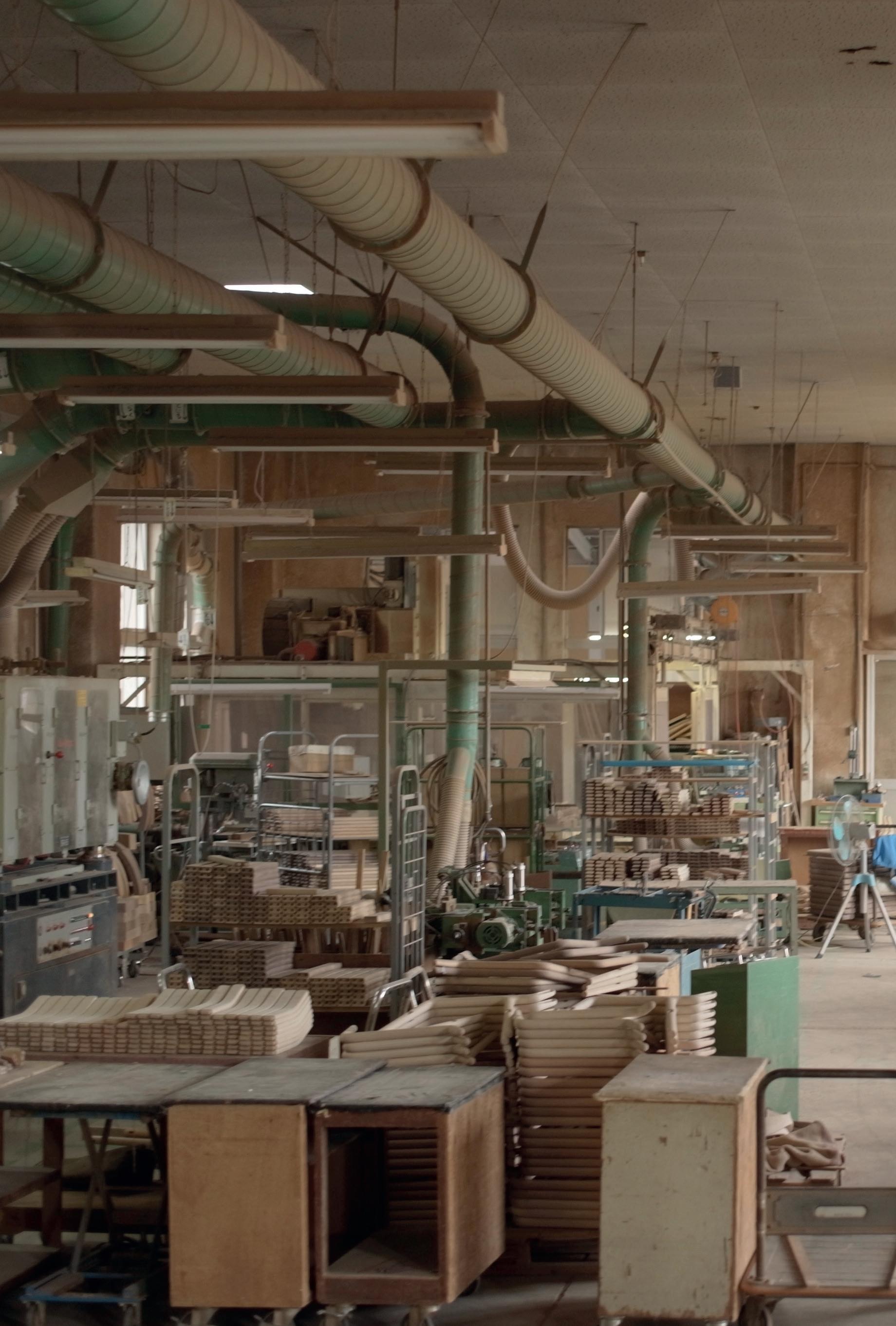
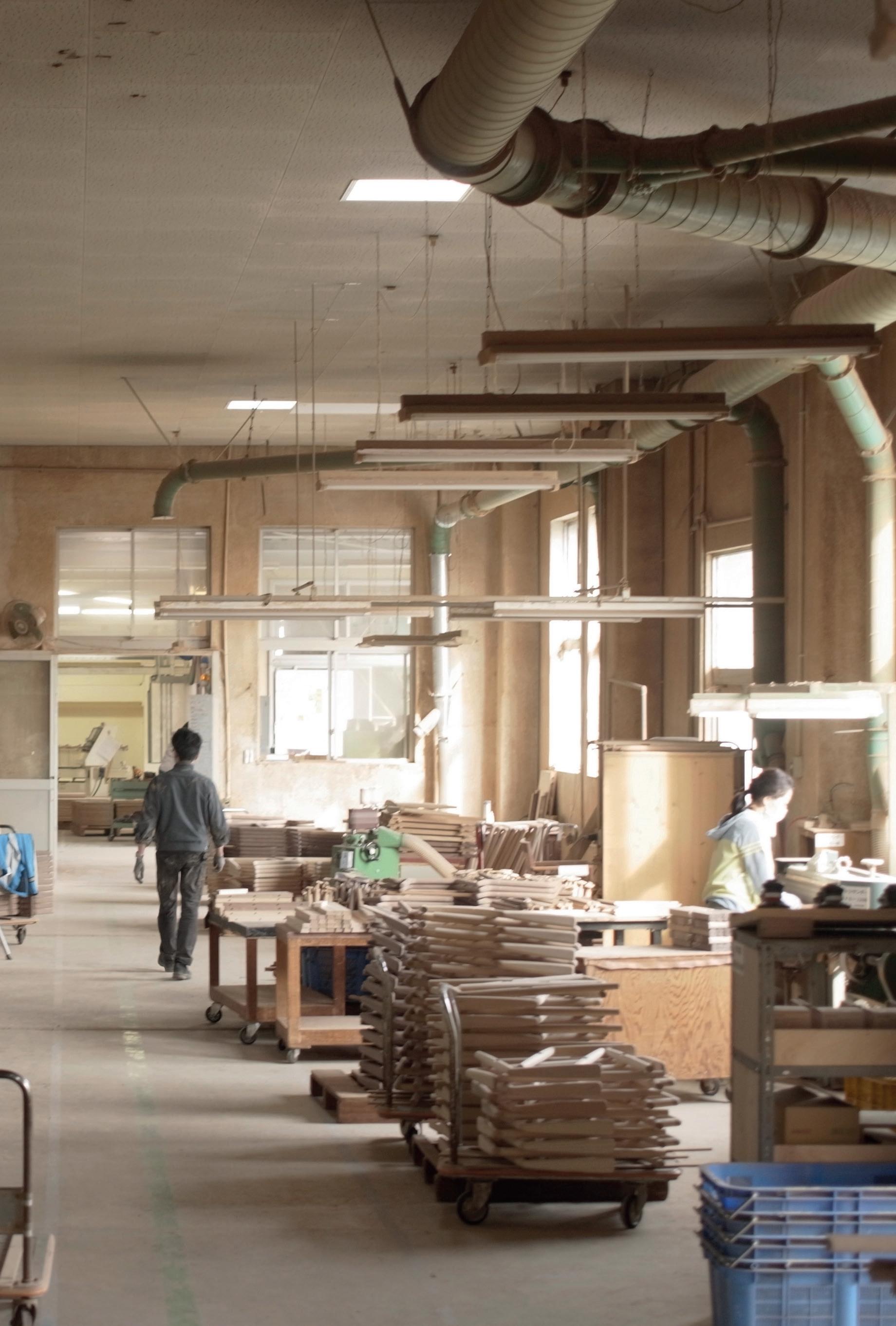

MIYAZAKI CHAIR FACTORY, A FAMILY HISTORY
2019 was a very special year for us as this is “the 50th anniversary of our founding” . At first, by this letter, I would like to express you all my deepest appreciation. Thank you again for your support during those years, nothing would have been be possible without you.
My father started this company in 1969. At the beginning, we were only manufacturing “dresser stools”, as an affiliated factory but we started to work on our own designs from 2000. Since then, we have been working on design development and manage to collaborate with Japanese and foreign designers. With a heart of gratitude, all the employees of the company will continue to make further efforts to give you the best we can develop and produce. For the next 50 years, we will strive to create new products that can be loved by everyone.
To celebrate this, we created a 50th Anniversary Limited Edition, which will only be available for a limited period of time. With this catalogue we will give you a little appatiser. Hope you like the collection as much as we do.
With my best and warmest regards,
Masahiro Miyazaki Representative Director and President Miyazaki Chair Factory Co., Ltd.
7
Sharing thoughts with Masahiro Miyazaki
宮崎 勝弘 - MASAHIRO MIYAZAKI 年2月13日生れ - BORN ON FEBRUARY 13, 1955 年 宮崎椅子製作所入社 - INTEGRATION OF THE COMPANY HELD BY HIS FATHER IN 1973 年 高治死去に伴い社長となる - BECAME PRESIDENT OF THE COMPANY AFTER HIS FATHER DIED IN 1993 年 デザイナーズブランドの製品開発を始める - STARTED HIS OWN BRAND WITH DIFFERENT DESIGNERS IN 1999 年 フォーリーサローネ出展 - FIRST APPARITION AT THE FUORI SALONE IN MILANO IN 2012
INTERVIEW - JAPAN, APRIL 2020
DID TAKAHARU, THE FOUNDER OF THE MIYAZAKI CHAIR FACTORY, ALREADY HAD PREVIOUS EXPERIENCE IN THE FURNITURE INDUSTRY?
My father, Takaharu Miyazaki, didn’t have any experience in furniture manufacturing. His younger brother, my uncle, had run a chair manufacturing company, so he helped my father when our company was established.
WHEN DID THE FACTORY BECOME A FAMILY BUSINESS?
Actually the Miyazaki Chair Factory has been a family business since the company was established in 1969. Right after I finished my design studies and graduated high school in 1973, I joined the company which was just founded, to support my father. When my father past away in 1993, I took over the company.
WHAT DISTINGUISHES MIYAZAKI FROM OTHER MANUFACTURES?
In my opinion, the strength of the company lies in its foundations. The Miyazaki Chair factory is a family business, where products are manufactured with love and dedication. In addition, we distinguish ourselves by our seniority. Over the years we have gained experience in every facet of furniture making. We do not shy away from any difficulties. Instead, we are constantly looking to improve ourselves.
“WE DO NOT SHY AWAY FROM ANY DIFFICULTIES. INSTEAD, WE ARE CONSTANTLY LOOKING TO IMPROVE OURSELVES.”
HOW DOES IT FEEL TO KNOW THAT THE MIYAZAKI COLLECTION ALSO WINS THE HEARTS OF OTHER CONTINENTS?
My team and I are very proud to know that our chairs are also valued far beyond Japan, especially by European countries that are well known for their famous chair manufacturers. During my design studies I learned about the different historical styles that Europe had developped during the 20th century. As a student I got
8 A FAMILY HISTORY
fascinated by the principles of Bauhaus. From that moment, I started dreaming to show our chairs to the European public. This dream became reality when we first exhibited our collection at the Milano Salone in 2012.
HOW DOES YOUR AVERAGE WORKING DAY LOOKS LIKE?
We always start the day with a morning meeting at 7:50a.m. It’s important that every employee is present during this briefing. After this gathering, each of them will get to their work. My job consists of helping where needed. I walk around the factory and the office for problem solving, judging things or giving instructions where necessary. During their entire working day, employees can always count on me when they have a question. At 5:00 p.m, I attend the end of the day meeting for about 30 minutes and say goodbye to the staff. Then, I usually spend 2 hours walking the dog and having dinner. After which, I go back to the office, contemplate or review things until 11:00 to 12:00p.m. Sometimes I even use the CNC machines at the factory to do some testings. I live right next to the factory, so I never found this routine to be hard. I love my job.
“THERE ARE NO RELATIVES AMONG MY EMPLOYEES, BUT THESE EMPLOYEES ARE LIKE MY FAMILY.”
WHAT DO WE HAVE TO KNOW ABOUT THE STAFF? HOW DO THESE EMPLOYEES FIND THEIR WAY TO THE MIYAZAKI FACTORY?
Today there are 33 employees working for Miyazaki Chair. Their average age is 39 years. The male-female ratio is almost equal: we employ 16 males and 17 females. There are some people who were interested in what Miyazaki chair factory does and moved in our area from other regions to work for the Miyazaki Chair Factory. There are also some people who wanted to develop their designs at our factory. In both cases my responsibility is to supply a comfortable and reliable environment to these peoples so they can stay longer with us and gain more experience, one of the foundations of making quality products. There are no relatives among the employees, but these employees are like my family.
9 A FAMILY HISTORY
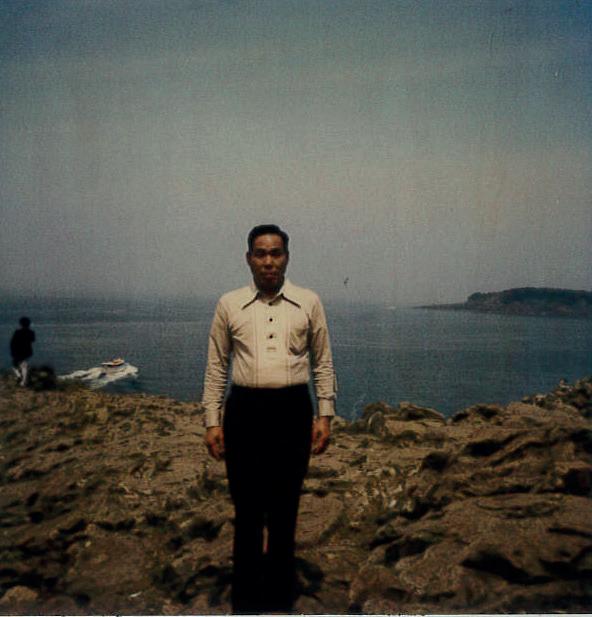
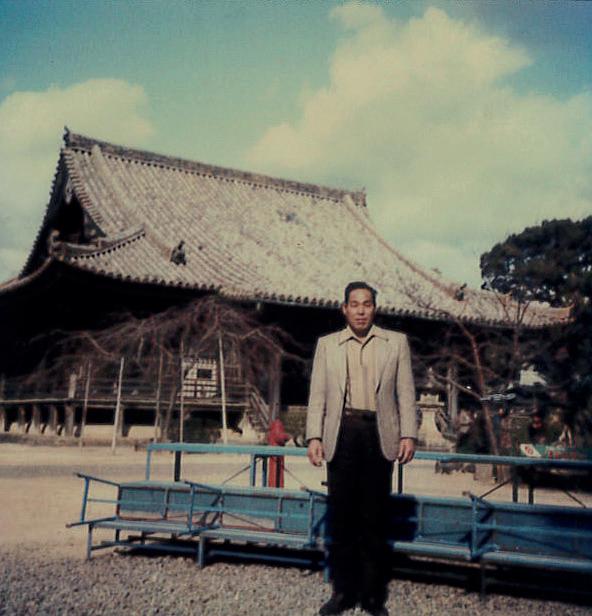
page 6
pages 10 - 11

10 A FAMILY HISTORY
Masahiro Miyazaki with next to him 2 members of the staff
Takaharu Miyazaki, father of Masahiro Miyazaki old picture of the factory
A FAMILY HISTORY
宮崎 高治
TAKAHARU MIYAZAKI 年7月3日10人兄弟の長男として生れる BORN ON JULY 3, 1926. OLDER BOY FROM A FAMILY OF 10 BROTHERS AND SISTERS. 年 宮崎椅子製作所創業
ESTABLISHMENT OF MIYAZAKI CHAIR FACTORY IN 1969. 工場移転 株式会社 宮崎椅子製作所設立
RELOCATION OF THE FACTORY AND ESTABLISHMENT OF THE MIYAZAKI CHAIR FACTORY CO,. LTD IN 1986. 年4月10日 67才にて没
PASSED AWAY AT THE AGE OF 67 YEARS OLD IN 1993.

11
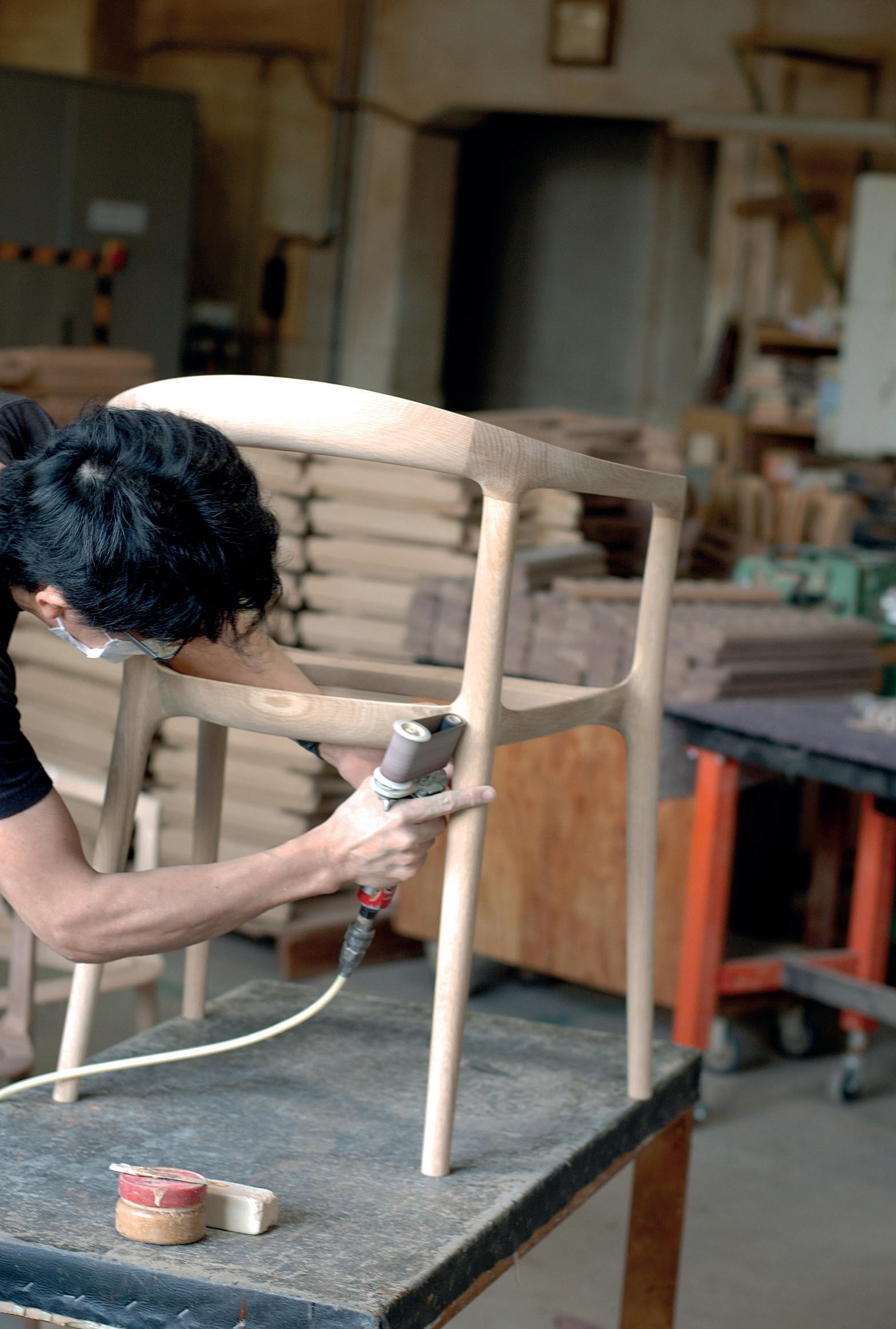
MIYAZAKI CHAIR FACTORY
DESIGN PRINCIPLES
Create something new and innovative. We want to create products that are comfortable to use and become your favorites in everyday life. We want to keep improving wooden chairs. These ideas form the core philosophy of the Miyazaki Chair Factory. Our aim is to produce, by combining design and technology, wooden chairs that are a result of creative and productive fusion.
As a guideline to achieve this goal, we have set out our criteria entitled “Creation and Production” composed of 10 themes.
These criteria are applied in the workshop-style design development laboratory where designers and craftsmen experiment together, as well as in the production process where precisely machined products are refined by delicate manual finishing. Examining the significance of each theme, our objective is to create wooden chairs that are ever better and more innovative, and will be used with affection in everyday life.
13
The technique of wood joint, as applied in wooden architecture, is an important factor in Japanese woodwork designs. The same tradition and technique are inherited in chair making that can be regarded as tiny wooden architecture. Although being simple, it provides a framework for creating excellent designs. A simpler design requires more advanced techniques.
木造建築でも活用されている「木を組む」技術は、日本の木のデザインを支える重要な要 素です。小さな木の建築ともいえる椅子づくりにも、この伝統と技術が受け継がれ、単純な がらも優れたデザインを生み出す背景となっています。シンプルなものほど、高度な技術 が要求されます。
A chair is comprised of several different parts. A knock-down chair is the one in which the work of fabrication is left to the users. Therefore, the parts of the chair which would otherwise not been seen or touched require extra precision. It was a challenge to refine not just the form but also the structure and the manufacturing processes.
椅子は、いくつかの部品で構成されています。それを組み上げずに、使い手が組み立てる ことで完成させるノックダウン方式の椅子は、通常なら見えないところが見えたり、触られた り、精度が要求されたり。造形だけでなく構造や製造方法を一から見直す挑 戦でもありま した。
Upholstering wooden parts with fabric or leather provides new possibilities in chair design. It is not meant to cover up the wooden parts. It is a technique to take advantage of wood as a material in finely adjusting the contact points between the wood and the fabric. While it is a traditional technique, it’s also a new approach in which innovation is required.
木部を布や革で覆うことで、椅子のデザインに新しい可能性が生まれます。それは、単に 木部を隠すことではなく、木と張り地の接点をぎりぎりまで調整しながら、木という素材を活 かす技術なのです。伝統的でありながら、常に革新が求められる新しい取り組みです。
We use natural, solid wood. Each wooden piece has unique colors and grains, and they are the ones that give each one of the chairs we make a one and only expression that will never recur. As we very much treasure this wonderful natural resource, we aim at product development with modest coloring and sorting, making the best of the raw material.
私たちが使う木材は、天然の無垢材です。一つとして同じものがない個性的な色や木目 があり、それが椅子に一期一会の表情を与えます。この素晴らしい資源を大切に使いた い。色の調整や選別はひかえめにして、素材をできるだけそのまま活かした製品開発をめ ざしています。
14 DESIGN PRINCIPLES | A Tree Of Chairs
As you carve a piece of wood, the colors and grains that have been hidden inside the wood are unveiled. It is a facet that could not been seen by just cutting the wood straight through. And, wood carving creates a form with a distinct curve. A piece of chair with sculptural beauty and comfy touch is created by carving out the wood up to the limit of its structural strength. 木を削ると、内部に潜む豊かな木目と色が現れます。真っ直ぐに切るだけでは得られない 表情。そして、独特な曲線を持ったフォルムが形づくられます。強度とのバランスをはかり ながら限界まで削ぎ落とすことで、彫刻的な美しさと手触りの良さを持った椅子が生まれ ます。
In order to shape wood into the three-dimensional structure of a chair, wood has to be connected together. We get out ideas to make a chair that is strong enough as a living ware, gives a sense of security at the structure, and even provides decorative aspects.
木材を立体的な造形としての椅子にするためには、木を繋いでいく必要があります。暮ら しの道具として必要十分な強度を兼ね備え、構造として安心感があり、それが装飾的に も活かされるアイデアを探り出す。新しい技法を丁寧に考えながら、椅子づくりに活用して います。
A tatami mat used to be a seating ware in Japan since ancient times. Rush grass, or igusa, used for making a tatami mat is a natural material with comfy touch gentle to the skin. We would like to shed a light on this quality Japanese material as chair cloth. We would like to be engaged in the manufacturing of products that are experienced in the five senses especially as chairs come into direct contact with the body.
日本では古来、座具であった「畳」。畳おもてに使われている「いぐさ」という素材は、肌に 優しく心地良い感触をもった天然素材です。この優れた日本の素材を椅子の張り地として 見直したい。体に直にふれる椅子だから、五感で感じる製品づくりに取り組んでいきます。
Splicing woods is a very important technique that determines the structure of a chair, and it also means using wood materials without unnecessary waste. The part that is spliced together becomes weak, but the know-how and the fine processing techniques of splicing is the one that makes up the weakness. Although splicing is not readily visible, it makes another face of the chair.
木を接ぐことは、木材を無駄なく利用することでもあり、椅子の構造的な成り立ちを決定づ ける大切な技術です。接いだ箇所は弱くなりますが、弱さを補うのが接ぎ方のノウハウと精 緻な加工技術です。見えない部分に隠されてしまう「接ぎ」は、椅子のもう一つの顔でもあ るのです。
15 DESIGN PRINCIPLES | A Tree Of Chairs
Most wood as a material is light enough to float on water. Taking advantage of its lightweight, we would like to make a product that is so light that one would be surprised when holding it up. Wood is a material with tenacity and strength despite of its lightweight. We tackle to make chairs with good strength and comfortable seating experience while pursuing the thinness of the structure.
多くの木は水に浮く軽い素材です。この軽さを活かして、手に持ったときに「えっ」と驚くよ うな製品もつくってみたい。木は、軽くても粘りのある強さをそなえた素材です。パーツの細 さと薄さを追求しながら、十分な強度と快適な座り心地がえられる椅子にも挑戦していま す。
The seat fabric and leather is one of the major factors which determine the character of a chair. We have challenged to make a product with unique coloring, making use of the local indigo dyeing techniques available in Tokushima for dyeing leather. We hope to be a manufacturer rooted in the local region with love of home even through tiny matters.
布や革の張り地は、椅子の個性を決定づける大きな要素です。私たちは地元徳島の伝統 的な藍染め技術を革の染色に使い、独特な色合いをもつ製品づくりに挑戦しました。小さ なことでも、徳島生まれを大切にする気持ちを持って、地域に根づいたものづくりをやって いきます。
A straight piece of solid wood is steamed to be bent into shape. Bentwood is a technique from old days but still provides the backbone for creating new designs. Using the primary characteristics of wood, this technique makes it possible to create rich and unique expressions, which would not otherwise be possible by just cutting out the wood, such as an organic line that fits the curve of the body.
真っ直ぐの木を蒸して曲げる。「曲げ木」は、古くからの技法でありながら、いまも新しいデザ インを生み出す背骨の役割を果たします。木材本来の性質を活かしつつ、切り出すだけ では実現しない豊かな表情を生み出す技術は、身体に添ったカーブと独特の個性を椅 子に与えます。
We have native trees in Japan that do not occur in other regions of the world. So, we would like to use these Japanese native woods, which have been long used for traditional architectures and interior decors, as much as possible. We continue to make use of softwood, which had otherwise been hard to use as a structure for making chairs, by exercising technical ingenuity. 日本には、他の国に無い固有の木があります。昔から現在にいたるまで、多くの建築や室 内装飾に活用されている日本の木を見直し、積極的に使っていきたい。椅子の構造体とし てはやわらかいために使いづらかった針葉樹も、技術的な工夫をほどこして製品化を続け ています。
16 DESIGN PRINCIPLES | A Tree Of Chairs
The last, fine process of finishing up a chair cannot be attained by machinery. It is indeed a process that can only be achieved through the touch and feel of the human hands. Although having the same shape, each piece of wood has slightly different characters. Our craftsmen read such differences by the hands and finish up each piece of chair devoting a great deal of time and care. It is only made possible by experienced craftsmanship. 椅子づくりの最後の細かな仕上げは、機械加工ではできない、まさに「手の感覚」だけが頼 りとなる工程です。木は同じ形でも、性格は微妙に違います。 その違いを手で読み取りながら一脚一脚 を手間ひま掛けて仕上げるためは、熟練した職 人の技があってはじめて可能となります。

page 12
DC10 during the production process
page 17
Masahiro Miyazaki and his wife, togheter with the staff in front of their workplace designed by architect Koizumi
17 DESIGN PRINCIPLES | A Tree Of Chairs
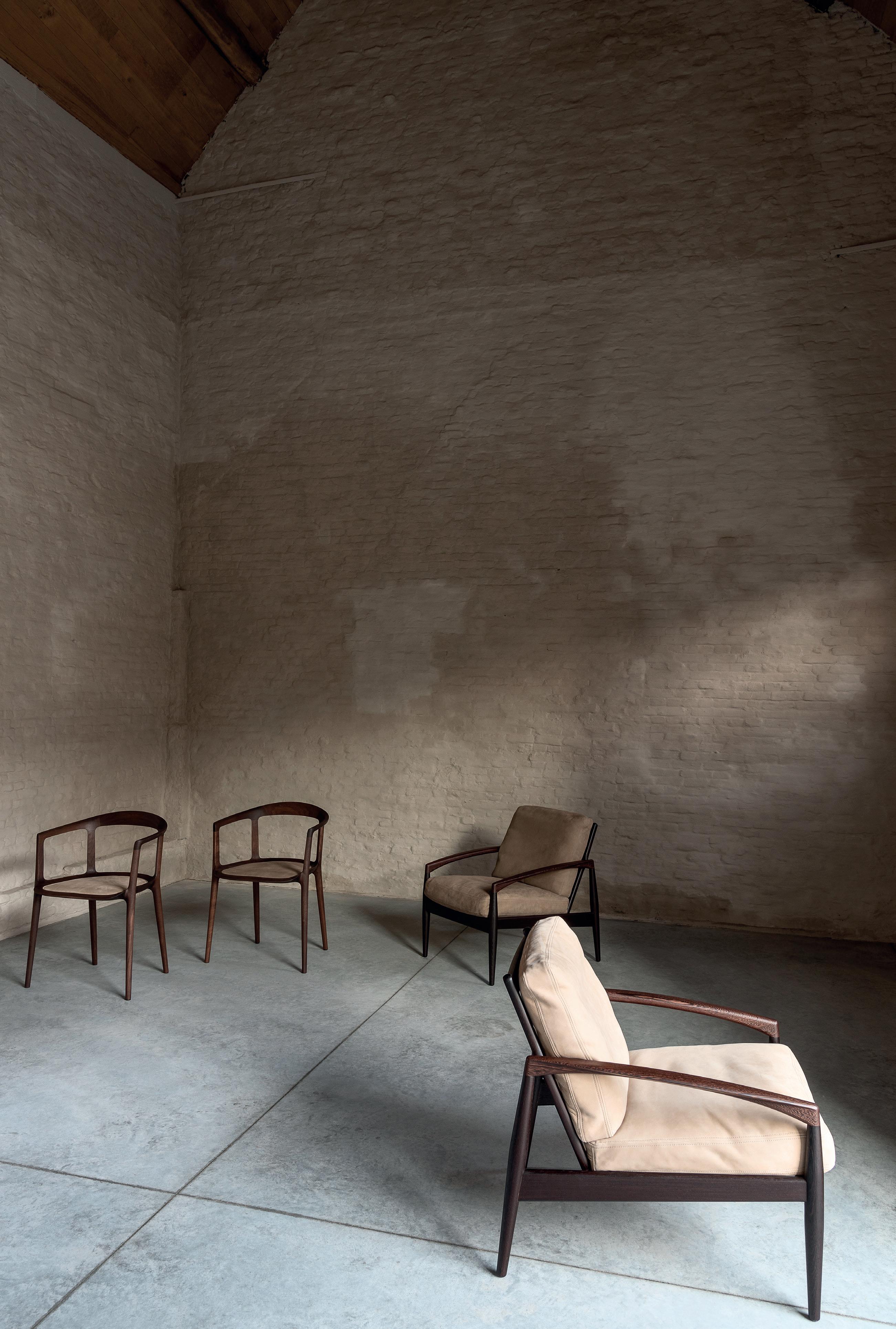
MIYAZAKI CHAIR FACTORY
50TH ANNIVERSARY EDITIONS
The 50th anniversary of the Miyazaki Chair Factory is celebrated this year with the launch of 2 special editions of the PAPERNIFE SOFA and the DC10 chair, two iconic models within the collection.
We would like to thank our good friend Kai Kristiansen for his treasure trove of wonderful designs including the PAPERKNIFE SOFA , the first piece that the Miyazaki Chair Factory reproduced for Kai.
Thanks also to Kyoko Inoda and Nils Sveje for designing the DC10 chair, a revolutionary and timeless chair that, without your perseverance and years of research together with Masahiro Miyazaki, never would have been created.
Kathy Alliët
ceo pas-partoe agenturen, N.V./S.A. Distributor Europe
Miyazaki Chair Factory Co., Ltd.
19
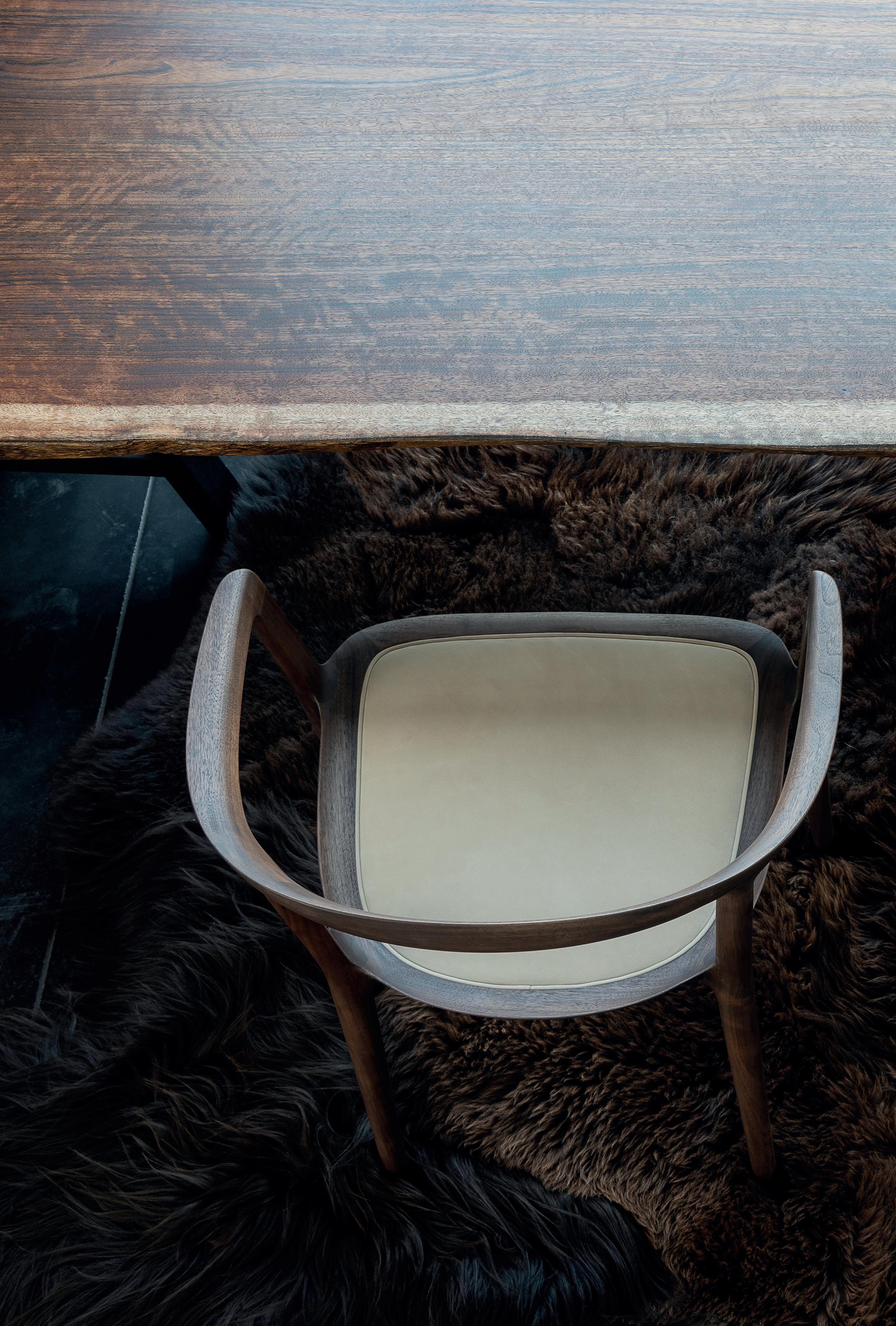

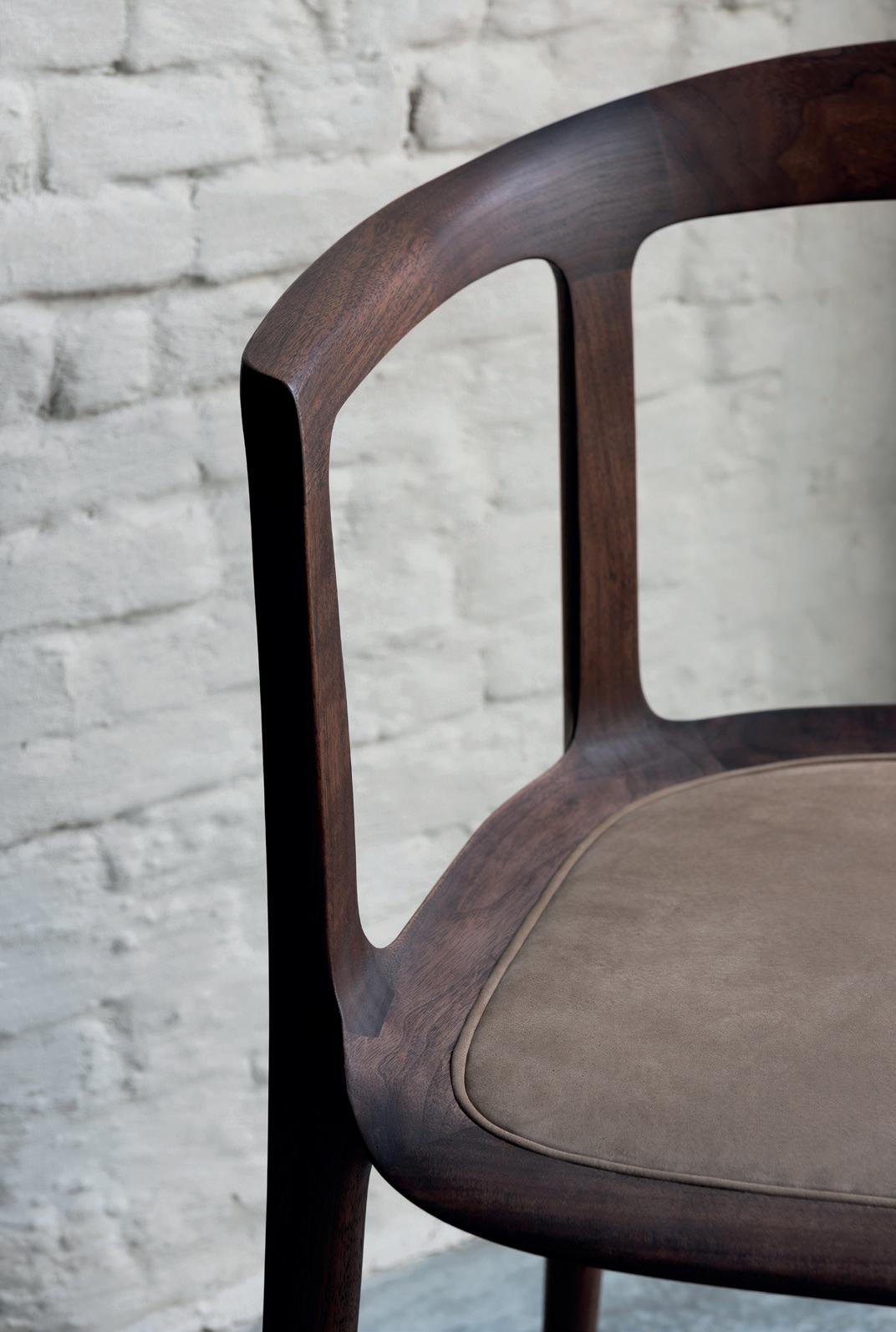
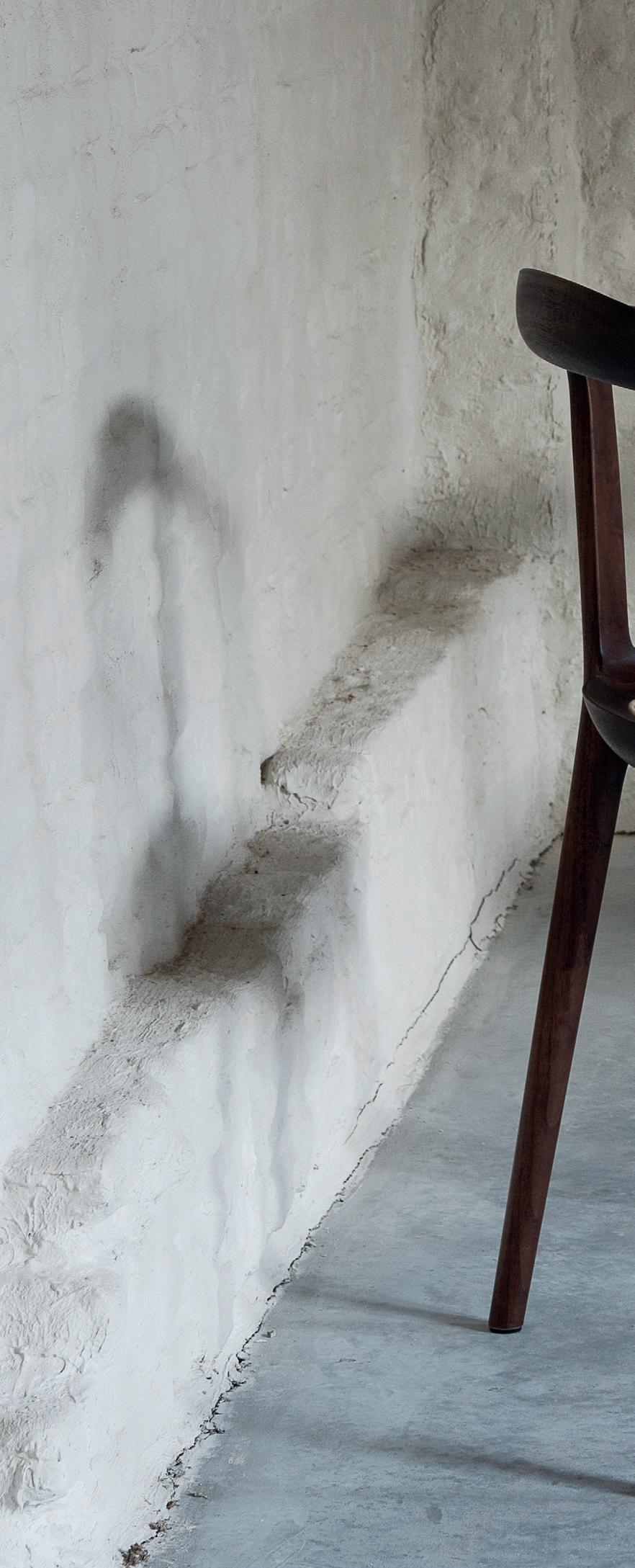
22 50th ANNIVERSARY EDITIONS
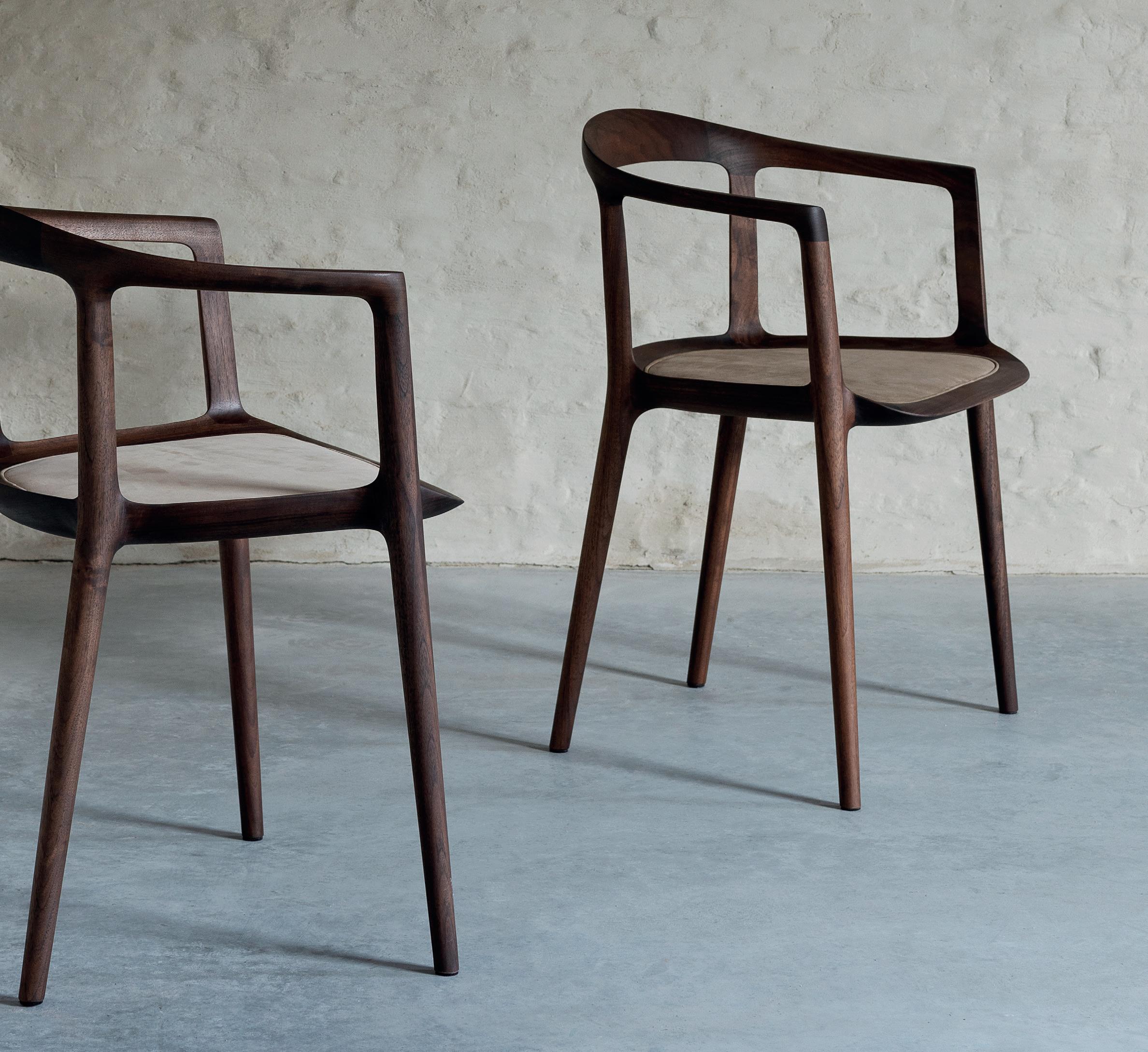
23
page 22
DC10 in almond, detail of the seat in nubuck
page 23
50th ANNIVERSARY EDITIONS
Left DC10 in ecru + Right DC10 in almond, frame walnut ebony
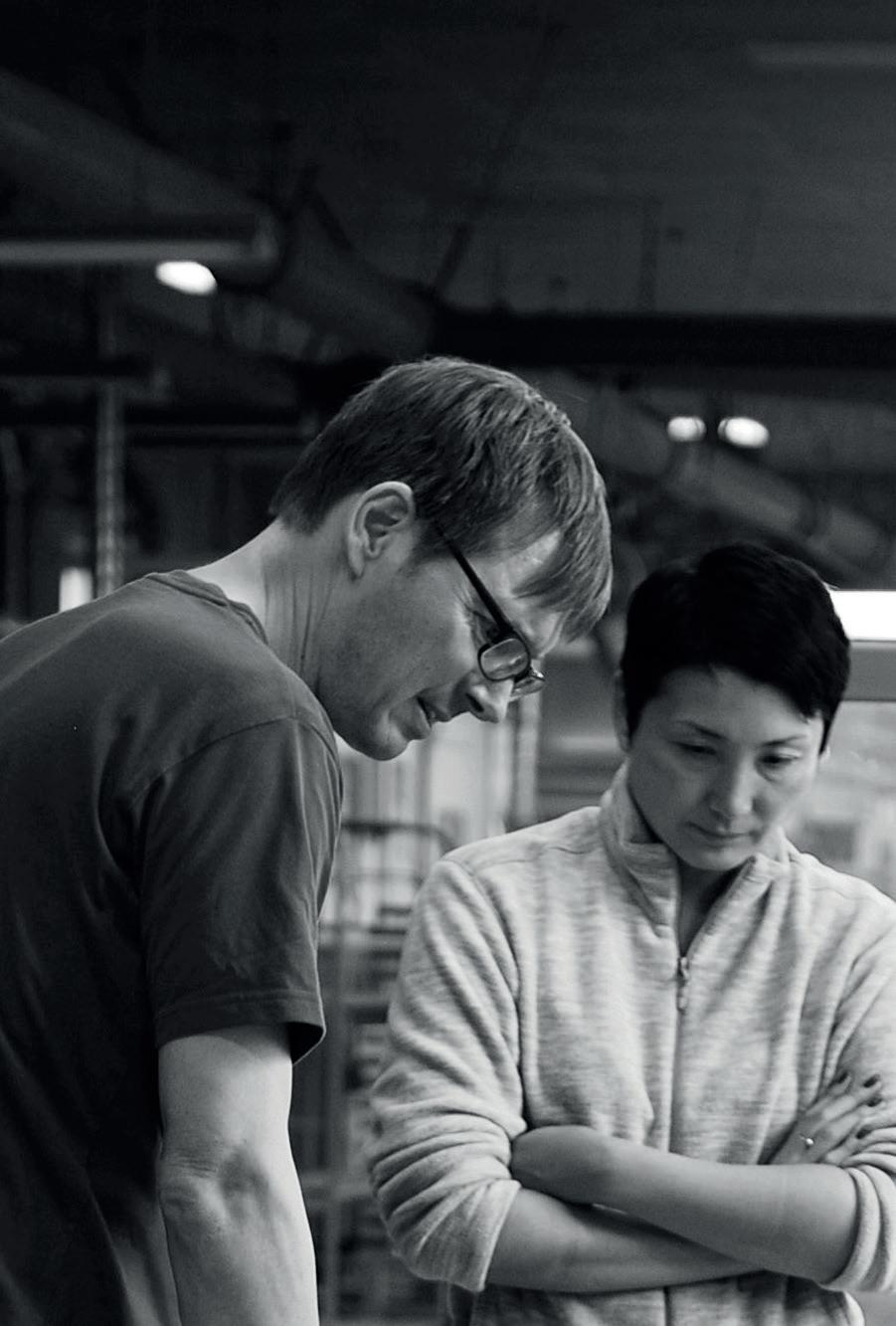
INODA + SVEJE designers of DC10 chair
1969 NILS SVEJE BORN AARHUS, DENMARK
1971 KYOKO INODA BORN IN OSAKA, JAPAN
1997 NILS GRADUATED AT THE ROYAL DANISH ACADEMY OF FINE ARTS (COPENHAGEN)
1999 KYOKO GRADUATED AT THE INSTITUTO SUPERIORE ARCHITECTURA E DESIGN (MILAN)
2000 IDEE DESIGN COMPETITION/FINAL LISTED
2002 PURE DESIGN AWARD/1ST PRIZE
2004 INTERNATIONAL DESIGN COMPETITION OSAKA/SPECIAL MENTIONS
2004 TAIWAN INTERNATIONAL DESIGN COMPETITION/FINAL LISTED
2005 ASAHIKAWA, THE INTERNATIONAL FURNITURE DESIGN/BRONZE LEAF
2005 ASAHIKAWA, THE INTERNATIONAL FURNITURE DESIGN/FINAL LISTED
2007 START COLLABORATION WITH MIYAZAKI CHAIR FACTORY
2010 SEOUL CYCLE DESIGN COMPETITION/GRAND PRICE
2010 GOOD DESIGN AWARD
2010 ASAHIKAWA, THE INTERNATIONAL FURNITURE DESIGN/FINAL LISTED
2011 IF PRODUCT DESIGN AWARD /GOLD (DC09)
2013 DESIGN FOR ASIA AWARDS /SILVER (DC10)
2014 ASAHIKAWA, THE INTERNATIONAL FURNITURE DESIGN/FINAL LISTED
2015 OPENED AN EXCLUSIVE FURNITURE SHOWROOM, LOCATED IN THE HEART OF MILAN
2019 IF PRODUCT DESIGN AWARD
2020 MARRIED COUPLE, LIVING AND WORKING IN MILAN, ITALY.
INTERVIEW - MILAN, APRIL 2020
HOW WAS THE DESIGN OF THE DC10 CHAIR BORN?
Kyoko + Nils: In fact, the design for the DC10 chair originated from the design for the DC09 chair. Those who want to understand the story behind DC10 must first know the origin of the DC09. DC09 was conceived from the very beginning as a traditional chair. In our opinion, the first sketches of the DC09 were a little too old-fashioned. We wanted to change this, we wanted to create something new. After all, as designers we are always looking to improve what already exists. So when we design, we will always be looking for new technologies. How can materials be used differently? How can we refine the production process and push technologies to the limit? We didn’t want to recreate a chair that looks like a design from the old days. We wanted to make a chair that fits in the here and now. A chair which can be a representative of this period. We wanted a creation that embodies this philosophy and sets an example for a new generation of chairs.
“WE WANTED TO MAKE A CHAIR THAT FITS IN THE HERE AND NOW. A CHAIR WHICH CAN BE A REPRESENTATIVE OF THIS PERIOD.”
At that time, there were also innovations at the Miyazaki Chair factory. Masahiro had just bought the latest CNC machine to refine their production processes. The use of this latest CNC for the furniture industry was groundbreaking, even for a country like Japan that is known for its progressive technology. To this day, however, the use of the CNC machine requires a great deal of insight and experience. It was therefore not surprising that Miyazaki Chair was not able to
25 50th ANNIVERSARY EDITIONS
utilise the capacities of the CNC sufficiently in the beginning. Also for us the use of the CNC machine was new. Fortunately, we were able to rely on the technical experience and expertise of Nils, who graduated as an engineer and already had a career in the technical development of medical devices and household appliances. But as designers, we were particulary interested in whether we could refine our design by using the CNC machine. For example, we wanted to see if we could integrate the wooden bars at the bottom and the seat of the chair, so that the design would look less heavy. By using the CNC machine, we were able to remove material wherever possible, which not only made the chair appear lighter but also made it lighter in weight than a traditional wooden chair. We only left material where structural necessary, and where unnecessary the material was made as thin as possible.
“WE ONLY LEFT MATERIAL WHERE STRUCTURAL NECESSARY, AND WHERE UNNECESSARY THE MATERIAL WAS MADE AS THIN AS POSSIBLE.”
Then we focused on the ergonomics of the seat. We invited numerous people of all shapes and sizes to test the chair. In order to improve it, the shape of the seat was then adjusted with units of only 1 millimeter. As a last step, we linked this technical know-how to an aesthetically pleasing shape. And so the DC09 chair was born after a two-year search. Due to the absence of a crosspiece at the seat, the DC09 became a unique chair within its category. After all, for a solid wooden chair it was highly exceptional that this crosspiece was omitted. When developing the seat of the DC09 Chair, we were driven by the urge to give the chair an expression of unity. The whole could be seen as one. At that moment, this was our primary design ambition. For each new design we have one goal in mind. We don’t put more that one concept in one product. We can consider the DC09 as a precursor of the DC10. With the difference that for DC10 we use an extra material. So in a sense, DC09 and DC10 share the same background. It was born as a reaction to our workshop organised for DC09. Watching the production machines and discussing with Mr. Mashahiro and his artisans during the 2-year search gave us inspiration for the DC10 Chair.
WHAT DO YOU CONSIDER AS THE NICEST DETAIL OF THE DC10 CHAIR?
Kyoko + Nils: The DC10 consists of only two surfaces. The chair is both shell and skeleton at the same time. Outside and inside lines come together in an extremely sharp edge. Sculpting surfaces knows no boundaries for us and could be seen as our main trademark. We invite you to let your hands wander over the curves of the wood and discover the different continuous forms.
26 50th ANNIVERSARY EDITIONS
Furthermore, we are convinced that the DC10 is a milestone within our designs. The design not only honours the historic furniture craft, but also the modern production technologies that live in the furniture industry today.
“DC10 IS A MILESTONE WITHIN OUR DESIGNS.”
HOW DID YOU GET IN TOUCH WITH THE MIYAZAKI CHAIR FACTORY?
Kyoko: I went looking for a Japanese manufacturer. During my search, I accidentally ended up on the Miyazaki Chair website. Attracted by the warm appearance of their wooden furniture in which I somehow thought I recognized a Danish atmosphere, I wrote a long “love letter” to Mr. Miyazaki. That same day I already got a positive message back, after which we decided to visit the factory in Japan. Since Japan is my homeland, I’m happy that I can go home often because of my job.
HOW DOES CULTURAL CROSS-POLLINATION BETWEEN ASIA AND EUROPE ADD VALUE FOR THE BRAND? ARE THERE CRUCIAL DIFFERENCES OR SIMILARITIES IN THE WAY BOTH CULTURES THINK AND OPERATE?
Kyoko + Nils: We will probably never know the answer to this question as there has always been a great willingness on both sides to surpass the differences between the two cultures. We tend to think that the biggest difference lies in the approach rather than in the ambitions or values. We share the same values when it comes to furniture design and this may also be true for our countries of origin, Japan and Denmark. Therefore, in our creative discussions we always try to express our values before we give form to them. By working this way we try to avoid possible differences in methodology. We mainly focus on what needs to be done in order to achieve a good end result.
WHAT IS YOUR BIGGEST SOURCE OF INSPIRATION WHEN DESIGNING YOUR FURNITURE?
Kyoko + Nils: It may sound rather vague, but our inspiration comes mainly from nature and from the artisan heritage based on it. No designer will ever be able to reproduce the formal perfection that is present in nature. Yet it inspires us again and again. And as designers we are not alone in following this principles, many have already preceded us. For example, we think of Henning Koppel, an iconic sterling silver designer known for his organic sculptures. This quality can also be found in all our designs. Volume, flowing lines, curves, surfaces and sharp edges are the common thread throughout our work.
27 50th ANNIVERSARY EDITIONS
“VOLUME, FLOWING LINES, CURVES, SURFACES AND SHARP EDGES ARE THE COMMON THREAD THROUGHOUT OUR WORK.”
HOW DO YOU APPROACH THE ECOLOGICAL ASPECT?
Kyoko+Nils: We spare no efforts nor expense when we produce our chairs at the Miyazaki Chair Factory. They are designed by hand, from idea and production to final use. We believe that high quality furniture will be treasured by people. So when you buy Miyazaki it will last for years and years. By opting for quality furniture, we can keep the carbon footprint low. This way our designs can be seen as eco-friendly.
WHO HAS TAUGHT YOU THE MOST ABOUT WOOD FURNITURE PRODUCTION?
Kyoko: For me, furniture history as a whole was particularly instructive. However, Danish chair history has always occupied a very important place in it. For inspiration, Nils and I used to go to vintage or auction stores to try and feel Danish chairs.
Nils: I learned a lot while working as an engineer in Denmark and through working with Mr. Miyazaki and the craftsmen. In terms of design, I gained a lot from Stefano Giovannoni designer for Alessi and Magis and known for the movement he applied on smooth curves.
HOW DO YOU SEE THE COOPERATION WITH MIYAZAKI DEVELOPING IN THE FUTURE?
Kyoko + Nils: After 4 years of intensive development, starting with 2 years for DC09 followed by another 2 years for DC10, we took some time to reflect. During those 4 years a lot has changed within the wooden furniture industry. By using the CNC machine to that extented level, the production process could be considerably improved. This in overlap with our personal ability that was getting better and better has resulted in the creation of these 2 “miraculous” chairs. We haven’t discussed it with Mr Miyazaki yet, but we’re alluding to make a new prototype during the course of this year. Filled with new ideas, we hope to surprise you as we also tried with our previous models.
28 50th ANNIVERSARY EDITIONS
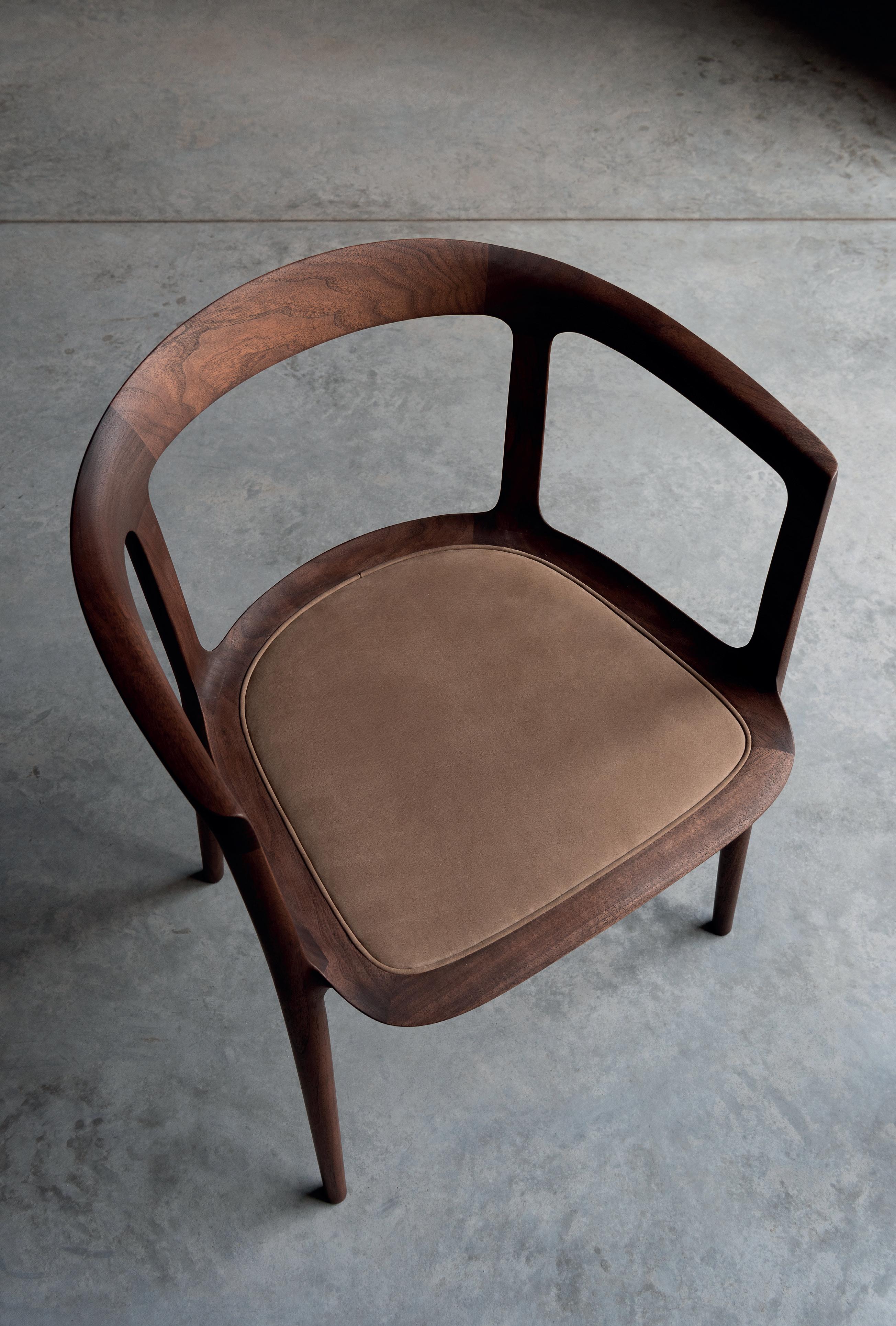
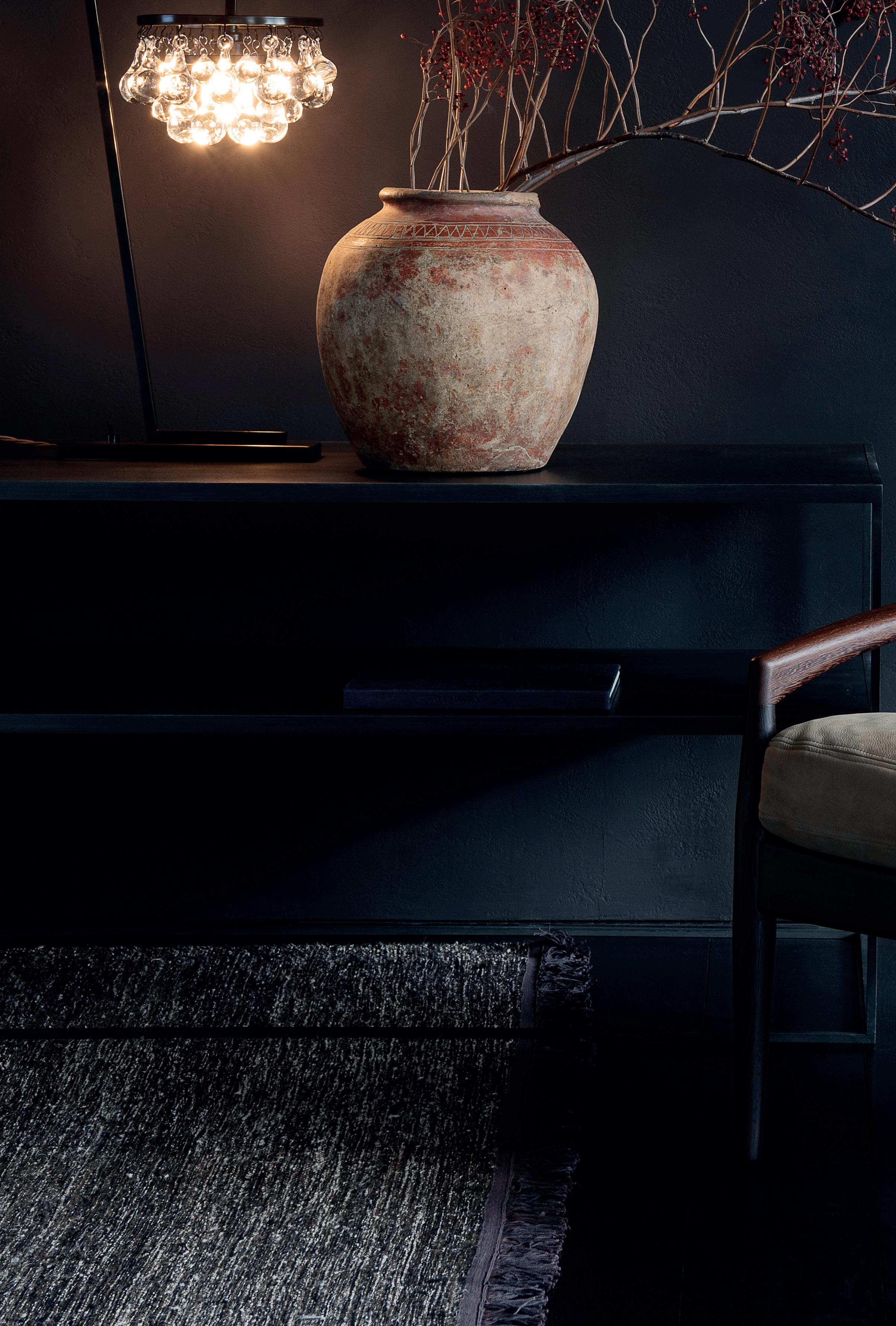
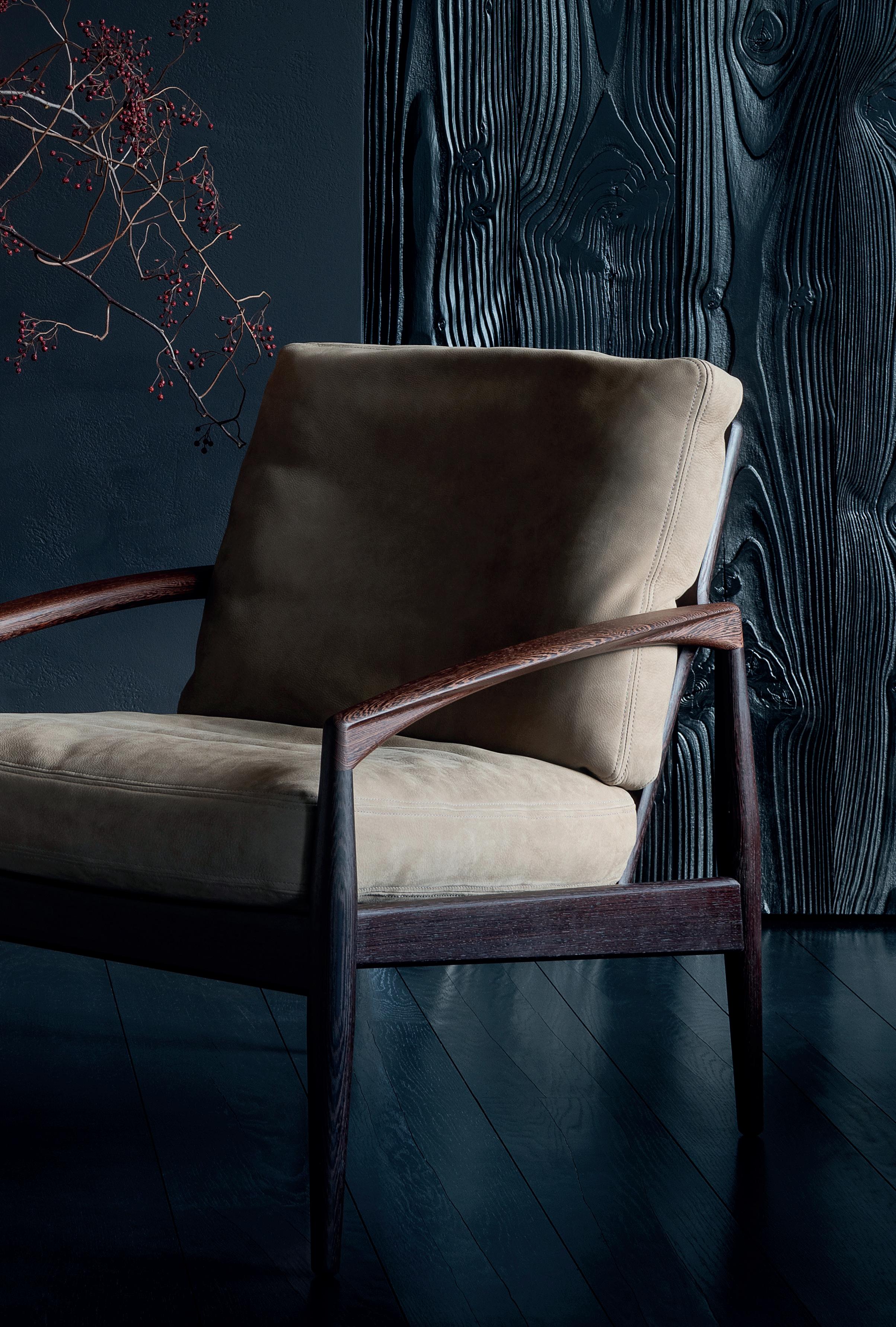

32 50th ANNIVERSARY EDITIONS
page 32
Paperknife Sofa in ecru, detail of the back and knife shaped armrests page 33
Left Paperknife in ecru + Right Paperknife in almond, Wengé frame

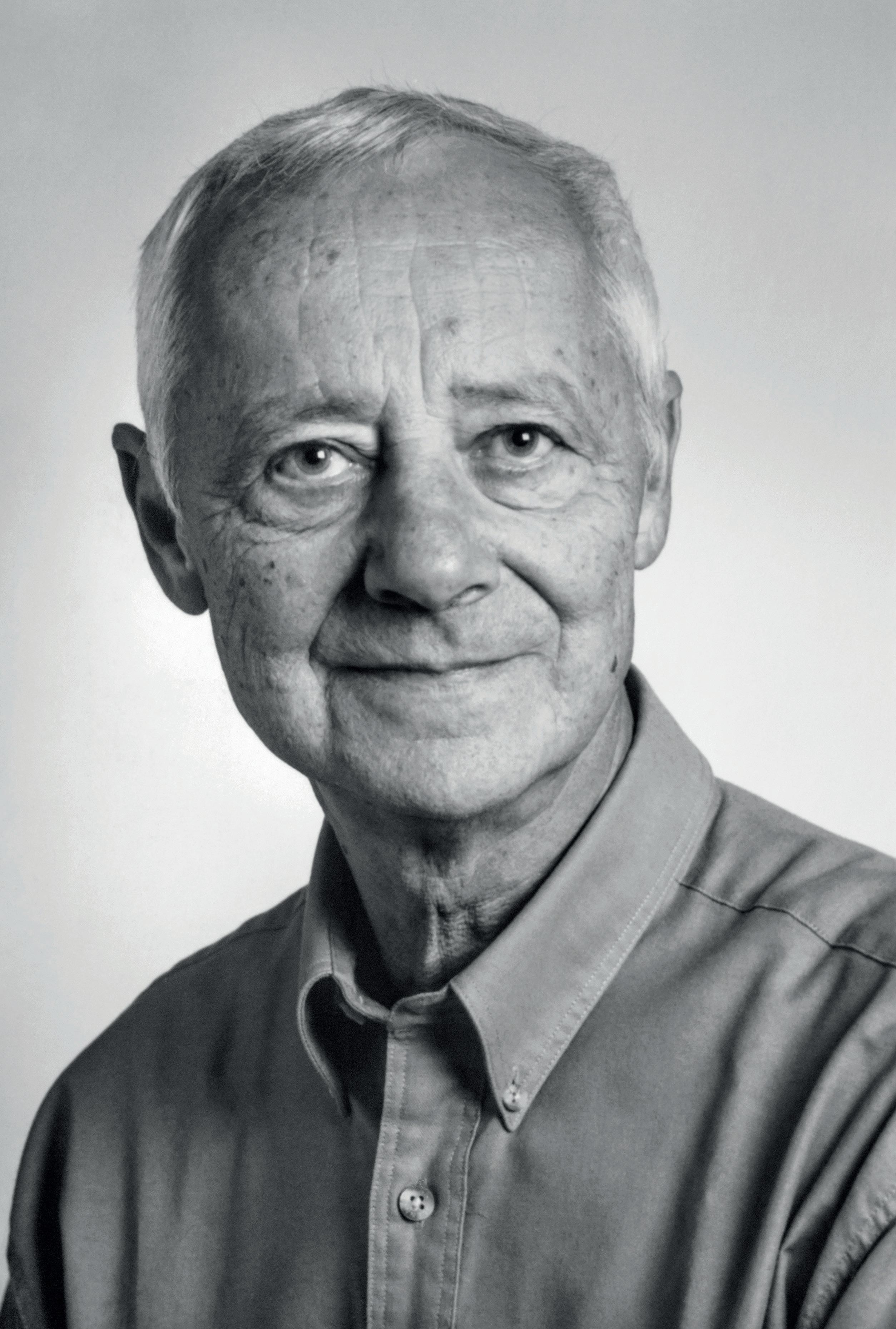
KAI KRISTIANSEN designer of Paperknife Sofa
1929 KAI KRISTIANSEN BORN IN HURUP, DENMARK
1953 GRADUATED FROM THE ROYAL DANISH ACADEMY OF FINE ARTS (COPENHAGEN)
1954 STARTED AS A FURNITURE DESIGNER WITH AS A FIRST DESIGN THE FM SHELVES
1956 – 1980 COLLABORATION WITH MAGNUS OLESEN
2008 START COLLABORATION WITH MIYAZAKI CHAIR FACTORY
2020 LIVING IN BRAEDSTRUP (DENMARK), STILL PUTTING FURNITURES INTO PRODUCTION
INTERVIEW - BRAEDSTRUP, APRIL 2020
CONGRATULATIONS KAI. TURNING 91 AND STILL BEING IN A GOOD HEALTH CONDITION, IS AN ACHIEVEMENT IN ITSELF. TURNING 91 AND STILL BEING ACTIVE AS A FURNITURE DESIGNER AND TRAVELLING AROUND THE WORLD TO DEVELOP DESIGNS, ON THE OTHER HAND, COULD BE CONSIDERED AS ABSOLUTELY EXTRAORDINARY. CAN YOU TELL US SOME MORE ABOUT HOW YOU COMPLETED AND STILL WORK ON THIS DESIGN ‘JOURNEY’?
Like many Danish furniture designers of my generation, I was apprenticed as a young boy as a cabinetmaker before enrolling in the renowned Royal Danish Academy of Fine Arts in Copenhagen, which at the time was headed by the very influential designer Kaare Klint. Whilst studying as an architect I was already captivated by furniture design. Some of my well-known designs, including 4110 chair reproduced today by Miyazaki, date back to my student days. However, I hadn’t had the chance to produce them during my studies.
“SOME OF MY WELLKNOWN DESIGNS, INCLUDING 4110 CHAIR REPRODUCED TODAY BY MIYAZAKI, DATE BACK TO MY STUDENT DAYS.”
After graduating from the academy, I opened my own studio in 1955 and started designing furniture in what would later become known as the ‘Danish modern’ style. Looking for a manufacturer for my designs, I rented a car and travelled around all the furniture factories in Jutland until I finally ended up at Magnus Olesen, an ambitious Danish furniture manufacturer who immediately saw potential in my sketches. In 1956, furniture maker Magnus Olesen showed my design of number 121 loungechair, now known as ‘paperknife’ sofa, at the annual Cabinet Makers Exhibition in Copenhagen, which was known for launching young designers. The 121 series, which turned into a complete seating collection, was the real breakthrough for Magnus Olesen, both in Denmark and far beyond. The collection was the most important product within the company for more than 10 years. Later, my chairs, desks, sideboards and hanging cabinets would be produced by other well-known Danish manufacturers such as Feldballes Møbelfabrik and Fritz Hansen. In that same year I designed, perhaps my most
35 50th ANNIVERSARY EDITIONS
celebrated design, the Z-chair or number 42. But it wasn’t the period when my career was at its peak. Even though my most celebrated designs date from this period. However, I certainly couldn’t complain. I was very good friends with the owner of IKEA and was able to bring some designs onto the market for him. The challenge of my designs was rooted in the technicity and craftsmanship needed to make them. Because this was missing or because preference was given to pieces that could be made by machine, many of my designs went out of production. Since so much time and skill was needed to complete just one piece, furniture manufacturers were unable to produce my designs in larger numbers. However, to this day, I have always remained loyal to the principles I learned during my student days. I was not in support of mass production and did not compromise on quality, certainly not on ergonomic detailing.
“THE CHALLENGE OF MY DESIGNS WAS ROOTED IN THE TECHNICITY AND CRAFTSMANSHIP NEEDED TO MAKE THEM.”
After 52 years of working, me as an architect and my wife as the owner of a hairdressing salon, we were ready to retire. We wanted to return to the village where we got married many years before. We sold our spacious country villa in Jutland and exchanged it for a much smaller apartment in Braedstrom, with the intention of growing old together in this place. Unfortunately, my wife became seriously ill. After her death, I fell into a black hole. All this time, I’d taken care of her. So I decided to focus on my other great love, namely furniture design. I set up my apartment as a true design studio and started working right away like never before. I could never have predicted this. During my move, for example, I had burned the too many sketches and sold the chairs and prototypes that I couldn’t give a place in my new apartment. So there was nothing else I could do besides buying my own furniture back at second-hand fairs and in vintage shops. That way I could continue working on these prototypes and rework older models.
“SO THERE WAS NOTHING ELSE I COULD DO BESIDES BUYING MY OWN FURNITURE BACK AT SECOND-HAND FAIRS AND IN VINTAGE SHOPS.”
Around the same period my designs were noticed by Japan. This resulted in a close collaboration with the Miyazaki Chair Factory. All these years, I had been looking for a manufacturer who shared the same design philosophies as me. But
36 50th ANNIVERSARY EDITIONS
in fact, I had never found one. However, when I travelled to Tokushima in 2010 to visit the factory, I was immediately overwhelmed. Their way of producing was not only according to the art of craftsmanship, as I had learned from my mentor Kaare Klint. They also had the most advanced machines and techniques at their disposal that made it possible to take designs to an even higher level. Everything was focused on quality rather than on quantity. A dream for a designer like me who is not satisfied by the ordinary. Under the direction of Masahiro Miyazaki, my second career took shape with the production of a new version of the 121 series or paper knife seating collection. We are two perfectionists bringing out the best in each other. Both characterised by the philosophy of ‘making chairs nobody else can make’. Thrilled by the possibilities Miyazaki has to offer, I haven’t sat still since then. Old designs were picked up again and were refined. New ideas were designed. I may be over 90 years old, but my to-do list hasn’t gotten any shorter.
WHY WAS ‘SERIES 121’ RENAMED AS ‘PAPERKNIFE SOFA’ COLLECTION?
This actually happened by accident. I never thought that my design, on the other side of the world, specifically in Japan, would be renamed after more than 60 years. The 121 series was a sofa collection consisting of oneseater with the reference ‘121’, a two-seater with the reference ‘122’ and a three-seater, referred to with the number ‘123’. When my design of the 121 one-seater was fine-tuned in Japan, the eye of the craftsmen immediately fell on the armrests of this oneseater. Personally, I also consider this to be the finest detail of the chair. After all, they reflect exactly what the design stands for: a combination of aesthetics and functionality. With their organic form the armrests created the impression and were reminiscent of the so-called guillotine scissors or paper scissors used to open letters. That is why this model was renamed as ‘paperknife’ sofa. And given the extent of the success of the reproduction of this model, this naming has become so familiar that hardly anyone remembers that the collection used to be called ‘121 series’.
WHAT’S THE THREAD RUNNING THROUGH YOUR WORK? WHAT DO ALL YOUR DESIGNS HAVE IN COMMON?
First and foremost, it is important to understand the period in which my designs were developed. After all, most of my known designs date from the fiftiessixties. In this period the focus lay mainly on minimizing the wood consumption. There was no room for unnecessary frills and mass production became the norm for many manufacturers. In order to meet this standard, my furniture was mostly built according to the knock-down principle. This would make transport faster and therefore cheaper. Although I have always kept this in mind and the economic aspect plays a very important facet within my design studies, the
37 50th ANNIVERSARY EDITIONS
main motivation for my designs came from ergonomics. I have always remained true to the design philosophy of my mentor, Kaare Klint, who pleaded for good craftsmanship and human-centred designs. Following his example, I tested my designs one by one to see if they satisfied human ergonomics. If not, I continued to refine them. In addition, I always tried to give shape to these ergonomic qualities with the greatest sense of sensitivity. In my case, this often resulted in strongly defined angles and clean lines. A design language that, in turn, demands excellent, almost superior craftsmanship. In addition, I always had a fascination for mathematical principles and will try to apply them when I look for a certain rhythm for example when designing cabinets. Nowadays, I’m often surprised by how contemporary technologies can lift my designs to a higher level over and over again. I have always been open for innovative ideas, so the possibilities we have at our disposal today are a great boost to my creativity.
“AS A TRIBUTE, AS THE LAST SURVIVING STUDENT OF THE ANCESTOR OF DANISH DESIGN, I WOULD LIKE TO EXPRESS HIS DESIGN PHILOSOPHY IN MY CONTEMPORARY FURNITURE.”
WHO OR WHAT DO YOU CONSIDER TO BE YOUR GREATEST SOURCE OF INSPIRATION?
As I mentioned earlier, I learned a lot from Kaare Klint. Kaare Klint was the first professor at our academy teaching ‘furniture art’. Like no other, he knew how to inspire young designers with his lessons. I remember, for example, that he organised classes about the human proportions. He approached furniture from a humanistic perspective, the functional and the practical always prevailed for him. He introduced the principle of the standard size in correspondence with the ergonomic needs. These and other design principles have been a guide for many designers of my generation, including Hans J Wegner and Poul Kjaerholm, and have found their reincarnation in the best of ‘Danish Modern’ today. However, when I was just admitted to the academy, Klint was very occupied with his own design practice and unfortunately in very poor health condition. He died in 1954 but managed to leave a lasting mark on my work. Borge Mogensen, his assistant and right hand, continued the work of Kaare Klint and inspired me again and again. Even though I think it’s a pity that we only knew each other for a few years, I am very grateful for my close partnership with Kaare Klint. As a tribute, as the last surviving student of the ancestor of Danish design, I would like to express his design philosophy in my contemporary furniture.
38 50th ANNIVERSARY EDITIONS
WHAT ARE THE DESIGN QUALITIES THE PAPERKNIFE SOFA HAS TO OFFER?
The Paperknife Sofa could be regarded as the prototype of the ‘fauteuille’. The armrests and soft back-angle are designed to allow the body to relax in an ideal way. I found inspiration in the business class seats of an airplane, because they are specially designed to be comfortably for a longer period of time. After research, I determined the appropriate inclination for the back, so that your belly is not squeezed as soon as you take a seat. The seat height and the height of the back were also designed in accordance with the human ergonomics. Furthermore, I worked out the armrests in the finest of details. For me, it’s an ideal sofa that combines the best of both worlds, beauty and functionality.
HOW WAS THE ‘SERIES 121’ LOUNGE CHAIR IMPROVED DURING ITS REPRODUCTION FOR THE MIYAZAKI CHAIR COLLECTION?
When we started reproducing the 121 lounge chair, we made three improvements in terms of both performance and design. I was told by Masahiro Miyazaki to drop the knock-down style. This wouldn’t benefit the strength and quality of the furniture in the long run. Next, cushions were exchanged for feather ones, which fitted better in the frame. Finally, the design itself was modified. The connection between arm and leg could be smoother according to Miyazaki. So we changed the shape of the arm to match the shape of the legs, which tapered upwards. Whoever slides his hand over the armrest will hardly notice the connection point between arms and legs.
“WHEN WE STARTED REPRODUCING THE 121 LOUNGE CHAIR, WE MADE THREE IMPROVEMENTS IN TERMS OF BOTH PERFORMANCE AND DESIGN.”
39 50th ANNIVERSARY EDITIONS
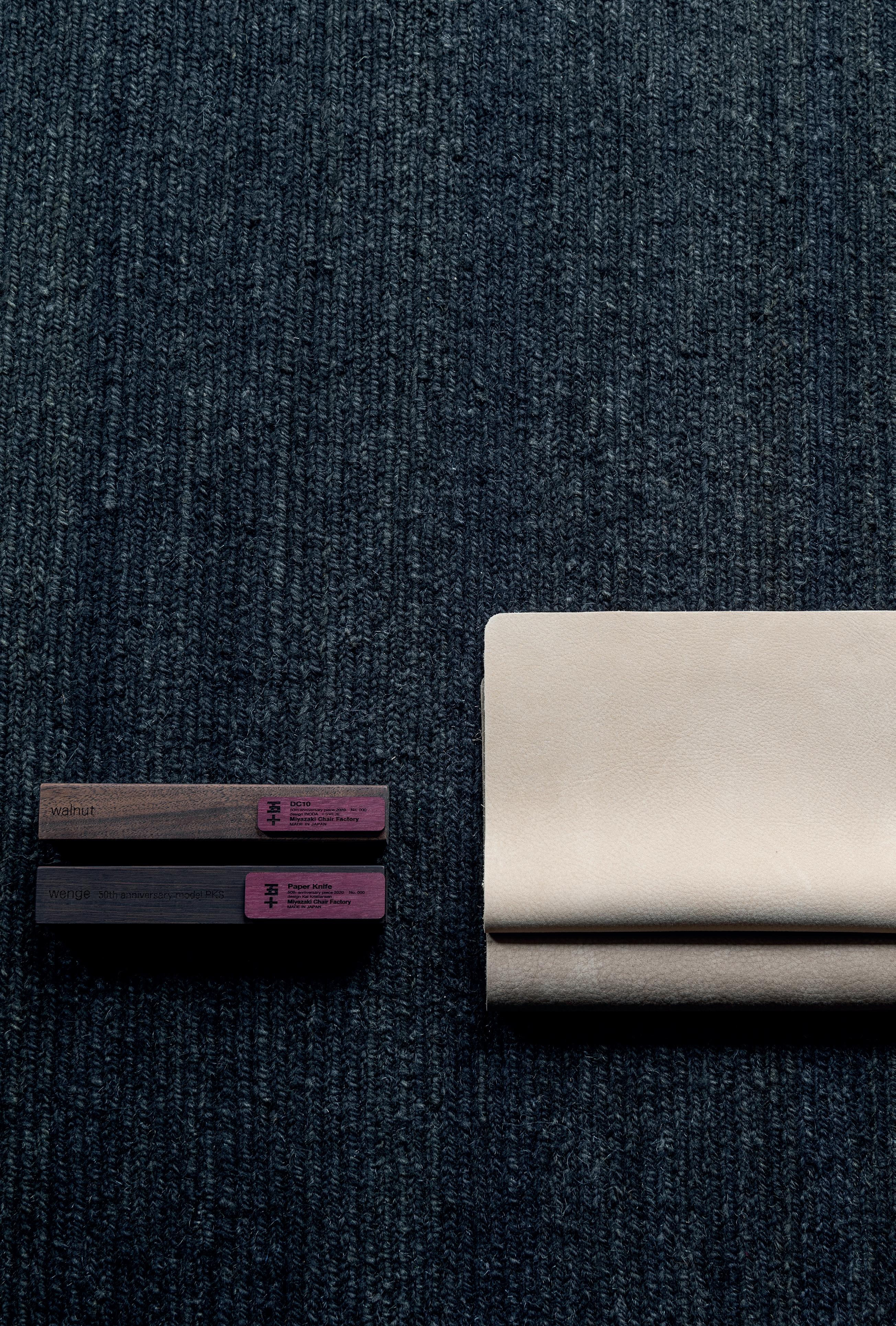
The Paperknife sofa 1-seater will be available with a wengé wooden structure and feather cushions upholstered with a soft nubuck leather in ecru or almond.
The same soft nubuck leathers have been selected for the seat of the DC10. The frame is made of walnut ebony.

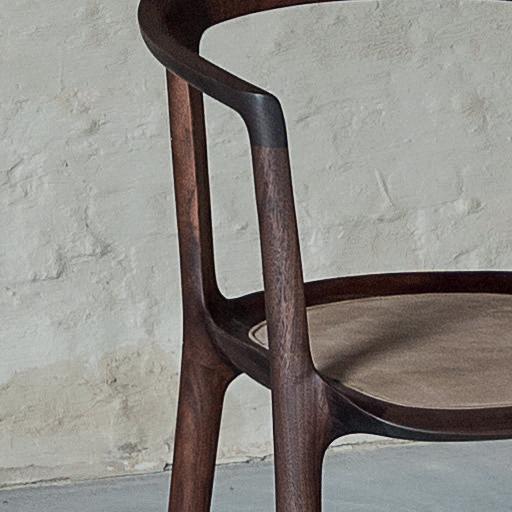


41 FINISHINGS
page 40
Leather and wood samples, of the 50th ANNIVERSARY EDITIONS
page 41
Left Paperknife Sofa in ecru + Right DC10 in almond frame wengé (Paperknife) and walnut ebony (DC10)
Pas-Partoe agenturen nv
Distributor Europe
kathy@pas-partoe.be
+32 3 866 40 66
Dorpsplein 2, BE-2830 HEINDONK
Art direction and graphic design: Louise Smits, studiosmits
Photography: Verne
Printing: Buroform
Locations: Pas-partoe interior
Thanks to:
Masahiro Miyazaki
Kyoko Inoda
Nils Sveje
Kai Kristiansen
Sisse Bro
April 2020
COPYRIGHT 2020 MIYAZAKI CHAIR ALL RIGHTS RESERVED
42 CONTACTS | CREDITS
www.miyazakichair.com



























